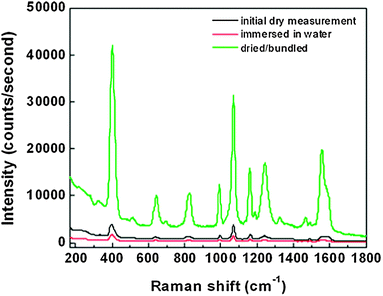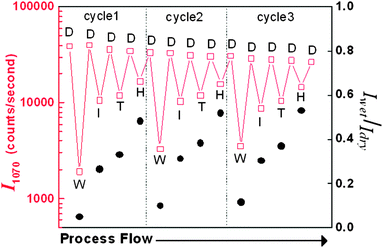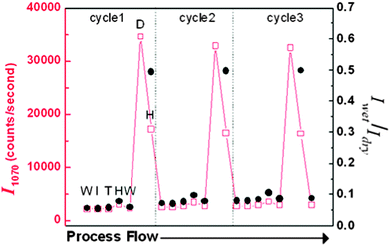Controllable and reversible hot spot formation on silver nanorod arrays†
Justin L.
Abell‡
*a,
Jeremy D.
Driskell
b and
Yiping
Zhao
a
aNanoscale Engineering and Science Center, University of Georgia, Athens, GA, USA 30602. E-mail: jabell1391@gmail.com; zhaoy@physast.uga.edu; Tel: +1 706 829 1391
bDepartment of Chemistry, Illinois State University, Normal, IL, USA 61790. E-mail: jdriske@ilstu.edu; Tel: +1 309 438 2663
First published on 7th November 2013
Abstract
Reversible hot spot formation is achieved for free-standing silver nanorod (AgNR) arrays fabricated by oblique angle deposition and modified with a hydrophilic surface coating.
Locations exhibiting exceedingly high enhanced Raman scattering on a noble metal surface, i.e. hot spots, are believed to be the contributing factor to the exceptional Raman enhancement generated by surface-enhanced Raman scattering (SERS) substrates. Hot spots are anticipated to primarily reside within nano-sized gaps in the interstitial space of nanostructure assemblies.1 In most studies, those hot spots are permanently formed and the SERS signals are mainly determined by how the molecules can be distributed on the hot spots during the sample preparation process. Yet, if the hot spots could be reversibly or dynamically formed and controlled, modulation of SERS signals to enhance signals from the desired analytes could be achieved. In addition, this could pave the way for re-usable, highly functional, and even ‘smart’ SERS substrates. Such a prospect, however, has been a rather elusive endeavor. Only recently have studies demonstrated the feasibility of using nanoparticle-based substrates to dynamically induce and control hot spot formation using modulation of temperature,2 pH,3,4 and DNA aptamers.5,6 These approaches either rely upon indirect detection of an extrinsic molecular label, or the need to change the sample environment in a way that may adversely affect biomolecule analytes. Ideally, however, dynamic hot spot formation should be expanded to incorporate other nanostructures beyond nanoparticles. High sensitivity coupled with direct, intrinsic analyte detection is also a highly desirable attribute. Moreover, additional versatility could be achieved if hot spot formation/disassembly was not dependent on pH or temperature modulation, but rather could be controlled mechanically via capillary forces. One possible method to achieve this is to use free-standing nanorods as SERS substrates. Unfortunately, previous studies only demonstrate transient formation of hot spots during solvent evaporation before spontaneously disassembling, mitigating the SERS signal.7,8 Clearly, a special type of nanorod substrate with proper functionalization is needed to permit more rigorous control over hot spot formation.
In this Communication we examine the reversible formation of hot spots within free-standing silver nanorods (AgNRs) produced with oblique angle deposition (OAD).9 The AgNRs are shown to bundle together in a non-destructive and semi-permanent manner to form hot spots when the nanorod film is treated with a liquid and then subsequently dried. Such a bundling effect is reversible when proper hydrophilic functionalization of the AgNR surface is achieved and the structure is immersed in solvent. We provide experimental evidence to demonstrate a mechanistic scheme of reversible AgNR bundling and hot spot formation. We show that such a process is effectively controlled via changes in the polarity of the solvent in contact with the AgNRs.
The high SERS enhancement of OAD-generated AgNR films reported previously is due to the hot spot formation during the nanorod bundling process caused by drying liquid in the nanorod film. To demonstrate this principle, an AgNR substrate was placed into a sealed container filled with mercaptophenol (MPh) vapor. After incubation in the MPh vapor for at least several minutes, the substrate was removed and measured. Only a very weak MPh SERS signal is reported as shown in Fig. 1. Then, the AgNR film is immersed into water and the SERS response is measured again, and found to be ∼50% lower than that of the initial dry signal. Then, the AgNR film is dried, and the SERS signal is once again measured. The dried sample produces a significantly stronger signal, up to 10-fold more intense than that of the initial vapor-treated AgNRs [see ESI† for more details]. These results contradict those reported in other studies in which SERS signal is enhanced only transiently as the liquid is evaporating and otherwise attenuated;7,8 however our results are consistent with another study where permanent hot spots resulted from drying-induced lateral bundling of the vertical nanorods.10 Microcapillary forces responsible for the bundling of high aspect ratio nanorod arrays during the drying process have been previously described.11,12 To confirm that the AgNRs undergo a similar drying-induced bundling mechanism SEM was performed. A top view SEM analysis of the AgNRs does not show any noticeable lateral change of the AgNR tilting direction, i.e. the AgNRs are highly parallel. However, a cross sectional SEM analysis reveals that the nanorod tilting angle decreases from ∼15° to ∼12°; consequently, the film thickness appears to decrease by ∼10% (ESI;† Fig. S1 and S2). This indicates that the water-treated film is becoming more compact, which will decrease the inter-AgNR spacing, and thereby increase the number of SERS hot spots, resulting in a higher SERS intensity. This same general structural behavior is observed for silicon OAD nanorods.11 Besides the SEM results, other evidences of bundling induced morphological change and SERS hot spots formation have been demonstrated through sheet conductance measurements and AgNR length dependent bundling studies (ESI;† Fig. S3–S5).
Although the bundling effect is responsible for the large enhancement observed for OAD-generated AgNRs, the ability to reverse and control such an affect is a highly desirable, yet elusive, characteristic for an advanced functional SERS substrate. However, if the surfaces of the bundled AgNRs can be sufficiently wetted, then adhesive forces holding the AgNRs together may be mitigated. When a highly packed MPh monolayer is formed on the AgNRs, the highly polar –OH groups are orientated away from the surface and therefore produce a very hydrophilic interface with the surrounding solution. Thus a highly polar liquid such as water may intercalate between the nanorod contact points, wet the polar OH–HO interface between the bundled AgNRs, and result in a (slight) separation of the bundled AgNRs. Due to this increased gap separation, and the resulting disassembly of the hot spots, the SERS signal of an analyte (in this case MPh) will therefore be drastically reduced to a level similar to that of the un-bundled state. On the other hand, a non-polar–hydrophobic liquid will not interact strongly with the highly polar–hydrophilic OH–HO interface between the bundled nanorods, and it is expected to have less effect on the already bundled AgNRs.
To test the possibility of this reversible effect, AgNR samples are coated with a self-assembled monolayer (SAM) of MPh via immersion in an aqueous MPh solution. A dried MPh-coated AgNR film shows a large SERS intensity (Idry) as expected, due to AgNR bundling. Since the polarity of the solvent is expected to affect the de-bundling, the polarity index P can be varied to test this effect, with a higher P indicating higher polarity. Therefore the MPh-coated AgNR substrate is immersed into a liquid solvent with a known P, and the SERS intensity is measured while wet (Iwet). Then the samples are removed from the solvent, rinsed thoroughly with water, dried, and Idry is measured again. In addition to water (Pwater = 10.2), this procedure is repeated on the same substrate subsequently with isopropanol (PIPA = 3.9), toluene (Ptoluene = 2.4), and hexane (Phexane = 0.001), yielding Iwaterwet, IIPAwet, Itoluenewet, and Ihexanewet, respectively. Note that all the solvent treatments do not involve additional thiol solution, i.e., the dry/wet treatments are with pure solvent.
The results of three cycles are shown in Fig. 2, with “□” representing the measured Idry and Iwet values and “●” denoting the ratio Iwet/Idry for different solvents. The Idry only shows a very slight decrease as the AgNRs are consecutively treated to different solvents and dried. The regeneration of the Idry signal after each solvent treatment implies that the MPh surface coverage is not changing significantly during the course of the experiment. The Iwet signal is highly dependent on the solvent, with an obvious pattern emerging: Iwaterwet < IIPAwet < Itoluenewet < Ihexanewet, likewise, the Iwet/Idry ratio for water, IPA, toluene, and hexane is 0.10, 0.30, 0.35, and 0.50, respectively, and demonstrates a strong correlation with P. Such a behavior is reproducible for at least 3 cycles, thereby dispelling any possibility for hysteresis or irreversible changes (e.g. analyte desorption, nanorod degradation, etc.), and therefore corroborating the aforementioned mechanistic scheme. For comparison, the same experiment was also repeated using another thiol, mercaptohexanol (MH), also with an –OH head group (ESI;† Fig. S6). As expected, the results are nearly identical to that obtained with MPh in Fig. 2.
However, these results do not explicitly assert that the AgNRs remain un-bundled in the presence of the non-polar solvents. For example, a non-polar solvent such as hexane may still force the hydrophilic AgNRs to bundle together to reduce the interfacial surface area between the AgNRs and the solvent. To test this, a fresh MPh-coated AgNR film is kept in water after functionalization with hydrophilic thiol, and Iwaterwet is measured. Then the sample is rinsed with IPA to displace all the water from the AgNR film, and then IIPAwet is measured. This process is then repeated with toluene and hexane where Itoluenewet and Ihexanewet are also measured without drying the sample. Finally, hexane is displaced with IPA and then water, the sample is dried and measured (Idry). The results for three such cycles are shown in Fig. 3. Iwaterwet, IIPAwet, Itoluenewet, and Ihexanewet are all found to be approximately the same, with a Iwet/Idry ratio value of ∼0.06. This implies that when the AgNRs are functionalized with a hydrophilic surface and in a de-bundled state, bundling is not strongly induced when immersed in a non-polar solvent such as hexane; the AgNRs remain de-bundled regardless of the liquid solvent environment. We note, however, that the hexane treatment does produce a slightly higher Iwet value, yielding the Iwet/Idry to be ∼0.08. This slight increase could be due to a slight degree of bundling induced by the hexane.
For each treatment, the Idry is approximately 10-fold larger than any of the Iwet measurements using any of the solvents as expected. Clearly, the AgNRs are only undergoing significant bundling during the drying process. Finally, to further illustrate the contrasting effect of hexane on the bundled AgNRs, the dried/bundled AgNRs are then immersed in hexane, and Ihexanewet is measured. As expected, in this case the intensity only decreases by approximately 50%, a value very similar to that observed for the hexane treatment from Fig. 2. Again, one may expect that the bundled AgNRs are to remain bundled in the presence of non-polar hexane, and that the observed 50% decrease is due to the changing dielectric environment of the AgNRs. Likewise, highly similar results are obtained with MH (see Fig. S7, ESI†).
For comparison, we repeated similar experiments with benzenethiol-modified AgNRs, a hydrophobic monolayer. We find that water does not de-bundle the AgNRs as much as IPA and toluene, which provide the greatest de-bundling, i.e. largest decrease in Iwet (Fig. S8, ESI†), whereas hexane produces an intermediate amount of de-bundling. Considering the aromatic structure of benzenethiol is similar to that of toluene, we may anticipate polarity matching between these compounds. Because IPA has a polarity similar to that of toluene, these compounds may interact more strongly with benzenethiol than hexane, which has a very low polarity index. Thus, toluene and IPA could be expected to cause de-bundling of the AgNRs treated with a monolayer of benzenethiol.
In conclusion, we have investigated how the structure of OAD-AgNRs, and therefore the resulting SERS properties, can be mechanically manipulated when these nanostructured films are treated with a liquid. Further studies will be needed to determine a more detailed inter-rod bundling mechanism and structure, but the current results suggest that the tip of one nanorod bundles with/contacts the top-side of the tilted nanorod directly in front of it. Thus, rather than discrete bundles, the entire AgNR film essentially becomes an interconnected network of bundled nanorods. The increased number inter-rod contacts are believed to produce hot spots, which greatly amplify the SERS signal of analytes adsorbed near these contact points on the AgNRs. When the surface of the AgNRs are properly functionalized with a hydrophilic thiol monolayer, e.g. MPh or MH, the bundled AgNRs can be de-bundled upon treatment with a highly polar solvent such as water, thereby reducing the number of hot spots and the overall SERS response. A similar response is observed with hydrophobic functionalization, e.g. benzenethiol, and toluene. The bundling/de-bundling is shown to be a highly repeatable process simply induced by drying/wetting the AgNR film, respectively. Elucidation of such a process has therefore provided essential insight into the hot-spot formation mechanism for these highly sensitive and reproducible SERS substrates. Discovery of this dynamic nano-actuation process broadens the scope for further functionality of both OAD-generated films and also for dynamic SERS nanostructure design.
This work was funded by NSF grant #CBET-1064228. The authors also thank Jeonifer Garren for help with the statistical analysis.
Notes and references
- E. C. Le Ru, Principles of surface-enhanced Raman spectroscopy: and related plasmonic effects, Amsterdam, Elsevier, 2009 Search PubMed.
- H. l. n. Gehan, L. Fillaud, M. M. Chehimi, J. Aubard, A. Hohenau, N. Felidj and C. Mangeney, ACS Nano, 2010, 4, 6491–6500 CrossRef CAS PubMed.
- P. Taladriz-Blanco, N. J. Buurma, L. Rodriguez-Lorenzo, J. Perez-Juste, L. M. Liz-Marzan and P. Herves, J. Mater. Chem., 2011, 21, 16880–16887 RSC.
- X. Qian, J. Li and S. Nie, J. Am. Chem. Soc., 2009, 131, 7540–7541 CrossRef CAS PubMed.
- J. Zheng, A. Jiao, R. Yang, H. Li, J. Li, M. Shi, C. Ma, Y. Jiang, L. Deng and W. Tan, J. Am. Chem. Soc., 2012, 134, 19957–19960 CrossRef CAS PubMed.
- N. H. Kim, S. J. Lee and M. Moskovits, Adv. Mater., 2011, 23, 4152–4156 CrossRef CAS PubMed.
- L. Yang, H. Liu, Y. Ma and J. Liu, Analyst, 2012, 137, 1547–1549 RSC.
- H. Liu, Y. Sun, Z. Jin, L. Yang and J. Liu, Chem. Sci., 2013, 4, 3490–3496 RSC.
- J. D. Driskell, S. Shanmukh, Y. Liu, S. B. Chaney, X. J. Tang, Y. P. Zhao and R. A. Dluhy, J. Phys. Chem. C, 2008, 112, 895–901 CAS.
- M. S. Schmidt, J. Hubner and A. Boisen, Adv. Mater., 2012, 24, OP11–OP18 CrossRef CAS PubMed.
- D. Chandra and S. Yang, Langmuir, 2009, 25, 10430–10434 CrossRef CAS PubMed.
- J. G. Fan, J. X. Fu, A. Collins and Y. P. Zhao, Nanotechnology, 2008, 19, 045713 CrossRef PubMed.
Footnotes |
| † Electronic supplementary information (ESI) available: SEM analysis of AgNRs before and after treatment with water, conductance measurements of AgNR films, SEM images of AgNRs with varying deposition thickness, Iwet/Idry ratios of varying length AgNRs, and SERS measurements of liquid treatment of MH-coated AgNRs. See DOI: 10.1039/c3cc45899g |
| ‡ Current address: Agiltron, Inc., 15 Presidential Way, Woburn, MA 01801. |
| This journal is © The Royal Society of Chemistry 2014 |



